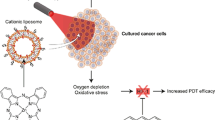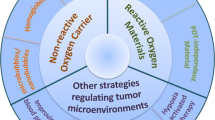Abstract
The conformation-dependent activity of azobenzene combretastatin A4 (Azo-CA4) provides a unique approach to reduce the side-effects of chemotherapy, due to the light-triggered conformation transition of its azobenzene moiety. Under hypoxic tumor microenvironment, however, the high expression of azoreductase can reduce azobenzene to aniline. It was postulated that the Azo-CA4 might be degraded under hypoxia, resulting in the decrease of its anti-tumor activity. The aim of this study was to verify such hypothesis in HeLa cells in vitro. The quantitative drug concentration analysis shows the ratio-metric formation of degradation end-products, confirming the bioreduction of Azo-CA4. The tubulin staining study indicates that Azo-CA4 loses the potency of switching off microtubule dynamics under hypoxia. Furthermore, the cell cycle analysis shows that the ability of Azo-CA4 to induce mitotic arrest is lost at low oxygen content. Therefore, the cytotoxicity of Azo-CA4 is compromised under hypoxia. In contrast, combretastatin A4 as a positive control maintains the potency to inhibit tubulin polymerization and break down the nuclei irrespective of light irradiation and oxygen level. This work highlights the influence of hypoxic tumor microenvironment on the anti-tumor potency of Azo-CA4, which should be considered during the early stage of designing translational Azo-CA4 delivery systems.

Similar content being viewed by others
References
Mollman J E. Cisplatin neurotoxicity. New England Journal of Medicine, 1990, 322(2): 126–127
Singal P K, Iliskovic N. Doxorubicin-induced cardiomyopathy. New England Journal of Medicine, 1998, 339(13): 900–905
Bae Y H, Park K. Targeted drug delivery to tumors: Myths, reality and possibility. Journal of Controlled Release, 2011, 153(3): 198–205
Lu D, Tao R, Wang Z. Carbon-based materials for photodynamic therapy: A mini-review. Frontiers of Chemical Science and Engineering, 2019, 13(2): 310–323
Kwon I K, Lee S C, Han B, Park K. Analysis on the current status of targeted drug delivery to tumors. Journal of Controlled Release, 2012, 164(2): 108–114
Wilhelm S, Tavares A J, Dai Q, Ohta S, Audet J, Dvorak H F, Chan W C W. Analysis of nanoparticle delivery to tumours. Nature Reviews. Materials, 2016, 1(5): 1–12
Hu Q, Bomba H N, Gu Z. Engineering platelet-mimicking drug delivery vehicles. Frontiers of Chemical Science and Engineering, 2017, 11(4): 624–632
Xin K, Li M, Lu D, Meng X, Deng J, Kong D, Ding D, Wang Z, Zhao Y. Bioinspired coordination micelles integrating high stability, triggered cargo release, and magnetic resonance imaging. ACS Applied Materials & Interfaces, 2017, 9(1): 80–91
Hu Q, Sun W, Wang C, Gu Z. Recent advances of cocktail chemotherapy by combination drug delivery systems. Advanced Drug Delivery Reviews, 2016, 98: 19–34
Webster R M. Combination therapies in oncology. Nature Reviews. Drug Discovery, 2016, 15(2): 81–82
Doroshow J H, Simon R M. On the design of combination cancer therapy. Cell, 2017, 171(7): 1476–1478
Li H, Li M, Chen C, Fan A, Kong D, Wang Z, Zhao Y. On-demand combinational delivery of curcumin and doxorubicin via a pH-labile micellar nanocarrier. International Journal of Pharmaceutics, 2015, 495(1): 572–578
Maeda H. Toward a full understanding of the EPR effect in primary and metastatic tumors as well as issues related to its heterogeneity. Advanced Drug Delivery Reviews, 2015, 91: 3–6
Peer D, Karp J M, Hong S, Farokhzad O C, Margalit R, Langer R. Nanocarriers as an emerging platform for cancer therapy. Nature Nanotechnology, 2007, 2(12): 751–760
Zhang P, Ye J, Liu E, Sun J, Zhang S J, Lee J, Gong J, He H, Yang V C. Aptamer-coded DNA nanoparticles for targeted doxorubicin delivery using pH-sensitive spacer. Frontiers of Chemical Science and Engineering, 2017, 11(4): 529–536
Mura S, Nicolas J, Couvreur P. Stimuli-responsive nanocarriers for drug delivery. Nature Materials, 2013, 12(11): 991–1003
Torchilin V P. Multifunctional, stimuli-sensitive nanoparticulate systems for drug delivery. Nature Reviews. Drug Discovery, 2014, 13(11): 813–827
Li X, Gao M, Xin K, Zhang L, Ding D, Kong D, Wang Z, Shi Y, Kiessling F, Lammers T, Cheng J, Zhao Y. Singlet oxygen-responsive micelles for enhanced photodynamic therapy. Journal of Controlled Release, 2017, 260: 12–21
Tao R, Gao M, Liu F, Guo X, Fan A, Ding D, Kong D, Wang Z, Zhao Y. Alleviating the liver toxicity of chemotherapy via pH-responsive hepatoprotective prodrug micelles. ACS Applied Materials & Interfaces, 2018, 10(26): 21836–21846
Gao J, Li J, Geng W C, Chen F Y, Duan X, Zheng Z, Ding D, Guo D S. Biomarker displacement activation: A general host-guest strategy for targeted phototheranostics in vivo. Journal of the American Chemical Society, 2018, 140(14): 4945–4953
He H, Sun L, Ye J, Liu E, Chen S, Liang Q, Shin M C, Yang V C. Enzyme-triggered, cell penetrating peptide-mediated delivery of anti-tumor agents. Journal of Controlled Release, 2016, 240: 67–76
Chen C, Zhao J, Gao M, Meng X, Fan A, Wang Z, Zhao Y. Photo-triggered micelles: Simultaneous activation and release of micro-tubule inhibitors for on-demand chemotherapy. Biomaterials Science, 2018, 6(3): 511–518
Liu Y, Liu Y, Bu W, Cheng C, Zuo C, Xiao Q, Sun Y, Ni D, Zhang C, Liu J, Shi J. Hypoxia induced by upconversion-based photo-dynamic therapy: Towards highly effective synergistic bioreductive therapy in tumors. Angewandte Chemie International Edition, 2015, 54(28): 8105–8109
Borowiak M, Nahaboo W, Reynders M, Nekolla K, Jalinot P, Hasserodt J, Rehberg M, Delattre M, Zahler S, Vollmar A, Trauner D, Thorn-Seshold O. Photoswitchable inhibitors of microtubule dynamics optically control mitosis and cell death. Cell, 2015, 162(2): 403–411
Engdahl A J, Torres E A, Lock S E, Engdahl T B, Mertz P S, Streu C N. Synthesis, characterization, and bioactivity of the photoisomerizable tubulin polymerization inhibitor azo-combretastatin A4. Organic Letters, 2015, 17(18): 4546–4549
Sheldon J E, Dcona M M, Lyons C E, Hackett J C, Hartman M C. Photoswitchable anticancer activity via trans-cis isomerization of a combretastatin A-4 analog. Organic & Biomolecular Chemistry, 2016, 14(1): 40–49
Rastogi S K, Zhao Z, Barrett S L, Shelton S D, Zafferani M, Anderson H E, Blumenthal M O, Jones L R, Wang L, Li X, Streu C N, Du L, Brittain W J. Photoresponsive azo-combretastatin A-4 analogues. European Journal of Medicinal Chemistry, 2018, 143: 1–7
Muroyama A, Lechler T. Microtubule organization, dynamics and functions in differentiated cells. Development, 2017, 144(17): 3012–3021
Castle B T, Odde D J. Optical control of microtubule dynamics in time and space. Cell, 2015, 162(2): 243–245
Perche F, Biswas S, Wang T, Zhu L, Torchilin V P. Hypoxia-targeted siRNA delivery. Angewandte Chemie International Edition, 2014, 53(13): 3362–3366
Li J, Meng X, Deng J, Lu D, Zhang X, Chen Y, Zhu J, Fan A, Ding D, Kong D, Wang Z, Zhao Y. Multifunctional micelles dually responsive to hypoxia and singlet oxygen: Enhanced photodynamic therapy via interactively triggered photosensitizer delivery. ACS Applied Materials & Interfaces, 2018, 10(20): 17117–17128
Hanahan D, Weinberg R A. Hallmarks of cancer: The next generation. Cell, 2011, 144(5): 646–674
Rankin E B, Giaccia A J. Hypoxic control of metastasis. Science, 2016, 352(6282): 175–180
Tang J, Huang C, Shu J, Zheng J, Ma D, Li J, Yang R. Azoreductase and target simultaneously activated fluorescent monitoring for cytochrome c release under hypoxia. Analytical Chemistry, 2018, 90(9): 5865–5872
Wang L, Huang X, Wang B, Zhao J, Guo X, Wang Z, Zhao Y. Mechanistic insight into the singlet oxygen-triggered expansion of hypoxia-responsive polymeric micelles. Biomaterials Science, 2018, 6(7): 1712–1716
Li M, Gao M, Fu Y, Chen C, Meng X, Fan A, Kong D, Wang Z, Zhao Y. Acetal-linked polymeric prodrug micelles for enhanced curcumin delivery. Colloids and Surfaces. B, Biointerfaces, 2016, 140: 11–18
Beharry A A, Woolley G A. Azobenzene photoswitches for biomolecules. Chemical Society Reviews, 2011, 40(8): 4422–4437
Piao W, Hanaoka K, Fujisawa T, Takeuchi S, Komatsu T, Ueno T, Terai T, Tahara T, Nagano T, Urano Y. Development of an azo-based photosensitizer activated under mild hypoxia for photodynamic therapy. Journal of the American Chemical Society, 2017, 139(39): 13713–13719
Verwilst P, Han J, Lee J, Mun S, Kang H G, Kim J S. Reconsidering azobenzene as a component of small-molecule hypoxia-mediated cancer drugs: A theranostic case study. Biomaterials, 2017, 115: 104–114
Dong M, Babalhavaeji A, Samanta S, Beharry A A, Woolley G A. Red-shifting azobenzene photoswitches for in vivo use. Accounts of Chemical Research, 2015, 48(10): 2662–2670
Wu S, Butt H J. Near-infrared-sensitive materials based on upconverting nanoparticles. Advanced Materials, 2016, 28(6): 1208–1226
Bandara H M, Friss T R, Enriquez M M, Isley W, Incarvito C, Frank H A, Gascon J, Burdette S C. Proof for the concerted inversion mechanism in the trans-cis isomerization of azobenzene using hydrogen bonding to induce isomer locking. Journal of Organic Chemistry, 2010, 75(14): 4817–4827
Aliprandi A, Mauro M, De Cola L. Controlling and imaging biomimetic self-assembly. Nature Chemistry, 2016, 8(1): 10–15
Meng L, Cheng Y, Gan S, Zhang Z, Tong X, Xu L, Jiang X, Zhu Y, Wu J, Yuan A, Hu Y. Facile deposition of manganese dioxide to albumin-bound paclitaxel nanoparticles for modulation of hypoxic tumor microenvironment to improve chemoradiation therapy. Molecular Pharmaceutics, 2018, 15(2): 447–457
Sheng Y, Nesbitt H, Callan B, Taylor M A, Love M, McHale A P, Callan J F. Oxygen generating nanoparticles for improved photodynamic therapy of hypoxic tumours. Journal of Controlled Release, 2017, 264: 333–340
Cheng Y, Cheng H, Jiang C, Qiu X, Wang K, Huan W, Yuan A, Wu J, Hu Y. Perfluorocarbon nanoparticles enhance reactive oxygen levels and tumour growth inhibition in photodynamic therapy. Nature Communications, 2015, 6(1): 8785
Kolemen S, Ozdemir T, Lee D, Kim G M, Karatas T, Yoon J, Akkaya E U. Remote-controlled release of singlet oxygen by the plasmonic heating of endoperoxide-modified gold nanorods: Towards a paradigm change in photodynamic therapy. Angewandte Chemie International Edition, 2016, 55(11): 3606–3610
Acknowledgements
The work was financially supported by the National Natural Science Foundation of China (Grant No. 21650110447).
Author information
Authors and Affiliations
Corresponding authors
Rights and permissions
About this article
Cite this article
An, Y., Chen, C., Zhu, J. et al. Hypoxia-induced activity loss of a photo-responsive microtubule inhibitor azobenzene combretastatin A4. Front. Chem. Sci. Eng. 14, 880–888 (2020). https://doi.org/10.1007/s11705-019-1864-6
Received:
Accepted:
Published:
Issue Date:
DOI: https://doi.org/10.1007/s11705-019-1864-6




